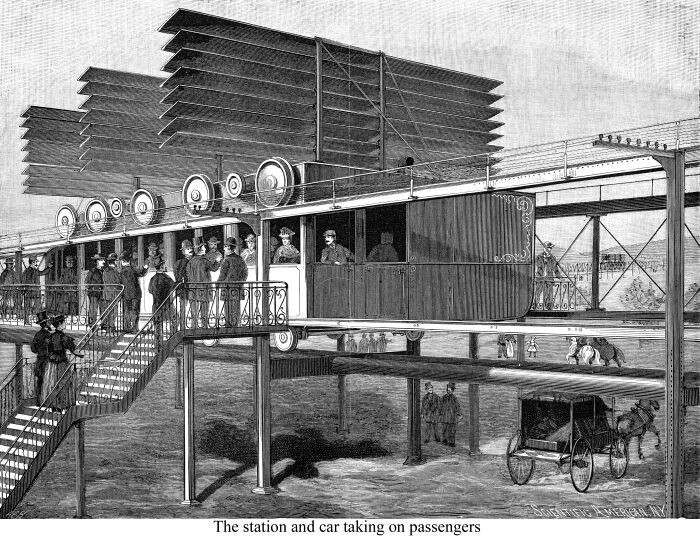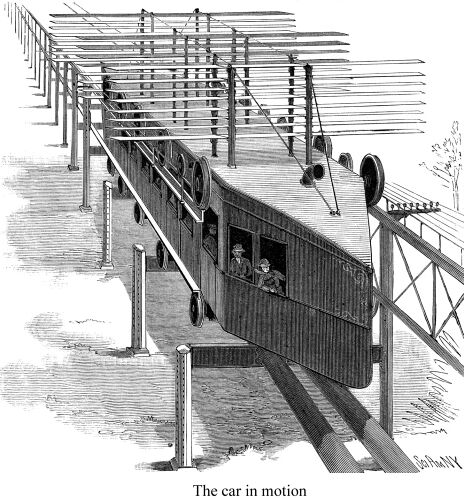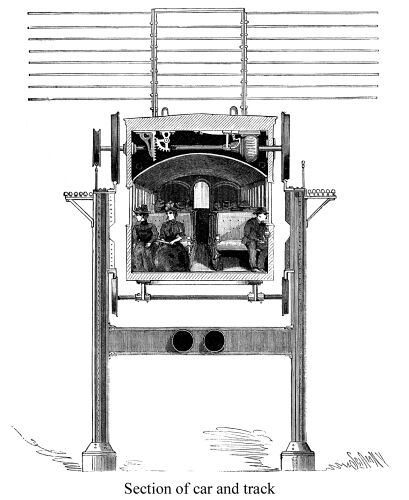THE CHASE-KIRCHNER AERODROMIC
RAILROAD.
Scientific American—May 5, 1894

We have given considerable space in our columns to the experiments
with aeroplanes, as executed by Prof. S. P. Langley, Hiram Maxim
and others. These experiments have led to the determination of
certain facts. A flat plate or surface maintained in a horizontal
position and moved horizontally through the air experiences a
greater resistance to its descent than it would if it descended
vertically. If the surface is inclined so that its advancing edge
is higher than the rear edge, it will experience a lifting effect,
and under proper conditions will rise upward. Such a contrivance
is termed an aeroplane. An aeroplane short in the direction of
its motion receives a relatively greater sustaining effect per
unit of its area than does a large one. A set of Venetian window
blinds gives the idea of a good arrangement of aeroplanes.
In the present issue we illustrate a proposed high speed railroad,
in whose operation aeroplanes take a part. By this system the
attainment of a speed of 150 miles an hour is claimed to be possible,
while for long distances a rate of 125 miles an hour is hoped
for. The projectors hold that the railroad of the present time
must be supplemented by some system admitting of higher speed.
To reach this speed, curves must be abolished, as the centrifugal
force will be too great to be withstood. Accordingly, as far as
possible, the line will go right across country from point to
point, without regard to grade. Next, the road must be free from
interruption; there must be no possibility of any obstacle getting
on the track. This makes an elevated structure the proper one,
and the one shown in the cut has been designed to secure the essential
features of strength and safety. It includes an upper and a lower
pair of rails, and a pair of trolley wires or leads.
 The cars are of special design, with sharp
ends, so as to encounter the minimum of air resistance. In cross
section they are of sufficient dimensions to present the comforts
of a Pullman car. They will have a trussed steel frame and metal
sides, tops and floors. They are carried by wheels four to six
feet in diameter, which wheels are to be placed near their tops,
so that the cars will be virtually suspended from the upper rails.
The axles of these wheels pass through journals near the car roof.
One or more pairs of these wheels are to have two electric motors
connected to their axles, so as to serve as driving wheels. The
speed being so high, there will be no trouble in using direct
connected motors without gearing. The cars are of special design, with sharp
ends, so as to encounter the minimum of air resistance. In cross
section they are of sufficient dimensions to present the comforts
of a Pullman car. They will have a trussed steel frame and metal
sides, tops and floors. They are carried by wheels four to six
feet in diameter, which wheels are to be placed near their tops,
so that the cars will be virtually suspended from the upper rails.
The axles of these wheels pass through journals near the car roof.
One or more pairs of these wheels are to have two electric motors
connected to their axles, so as to serve as driving wheels. The
speed being so high, there will be no trouble in using direct
connected motors without gearing.
The current is taken from each trolley wire by its trolley
wheel, which works on an axle at about the level of the axle of
the driving wheels. On the trolley wheel axle, which will be insulated,
are secured collecting rings, against which brushes bear. A closed
metallic circuit is to be used, two trolley wires and a pair of
trolley wheels being used on each car.
So far all is simple enough, the peculiarities of the system
centering on the points of straightness of line, lowering of center
of gravity of car below the rails, and high speed. It is essential
that there should be no curves, and any grade met is to be climbed;
no deviation of route to secure an easy grade is to be allowed.
This will give many severe ascents to be overcome, and it is
here that the distinguishing peculiarity of the system comes in.
The car carries a series of aeroplanes, each one twenty to thirty
feet long and four to five feet wide. They are mounted so as to
be capable of setting at any desired angle. At a speed of 150
miles an hour, a slight inclination would give them a very powerful
lifting effect. On the level they will be kept practically straight.
When a grade is reached they will be set at an angle, so as to
have a lifting effect. This will be graduated, so as to leave
just enough traction in the driving wheels to propel the cars.
It is obvious that the limit might be passed, and the wheels might
turn without getting grip enough to drive the train. Here a self-regulating
feature is apparent. If the wheels slipped, the car would move
with reduced velocity and the aeroplanes would lift less weight.
At once the traction would increase and the car would move forward,
so that eventually an equilibrium would be established. It is
claimed that the amount of work necessary to drive a car at high
speed up a grade would be greatly diminished by the use of aeroplanes.
 Underneath the car is a second set of wheels,
ordinarily inactive. Above them is a line of rails inverted. By
a system of levers and an air pump the engineer can throw these
wheels upward at will, so that they will press against the lines
of rails above them. This affords a means of increasing the traction
to any desired extent, as the upper and lower wheels are thus
made to act as the jaws of a clutch. The increased rolling friction
thus produced may be applied for direct traction or for braking.
These wheels also provide a safeguard against all swaying, or
lifting of the car from the track by the aeroplanes. Underneath the car is a second set of wheels,
ordinarily inactive. Above them is a line of rails inverted. By
a system of levers and an air pump the engineer can throw these
wheels upward at will, so that they will press against the lines
of rails above them. This affords a means of increasing the traction
to any desired extent, as the upper and lower wheels are thus
made to act as the jaws of a clutch. The increased rolling friction
thus produced may be applied for direct traction or for braking.
These wheels also provide a safeguard against all swaying, or
lifting of the car from the track by the aeroplanes.
In the running operation the engineer will be guided by the
nature of the ground. On the level he would probably hold the
aeroplanes flat and inactive. When a grade is reached, he will
incline them enough to partially lift the car. The car then begins
to move up in part at least upon an inclined plane of air. Its
acquired velocity as well as direct traction assist this operation.
It reaches the top of the grade with slightly reduced velocity,
but very quickly recovers its loss. On a down grade the aeroplane
may be inactive or may be turned so as to provide an enormously
powerful aeroplane brake.
It is proposed to use alternating current motors, which on
present lines would admit of a distance between power stations
of some 200 miles. It is claimed for the system that it is as
safe as the present one, has greater speed and equal comfort and
luxury, is adapted to all kinds of traffic, and will be profitable.
It is calculated that a straight line from New York to San Francisco
would be 500 miles shorter than the present one. The construction
of an elevated road across the continent seems an appallingly
great piece of work, but in the United States to-day there are
railroad bridges enough to give a continuous line of track from
Sandy Hook to the Golden Gate. The absence of snow blockades and
washouts, the abolishing of the expense of replacing railroad
ties and of maintaining a ground track, the economy of the trolley
system, the power to utilize water wherever met with near the
line, are cited as advantages. New York and San Francisco would
be brought within twenty-four hours of each other, and a route
crossing Bering's Strait would bring Paris nearer in point of
time than it now is by the ocean route. The use of the structure
for pneumatic tubes, telephone and telegraphic wires, is obvious
and is suggested by the projectors.
Oddities Page
| Contents Page
|







